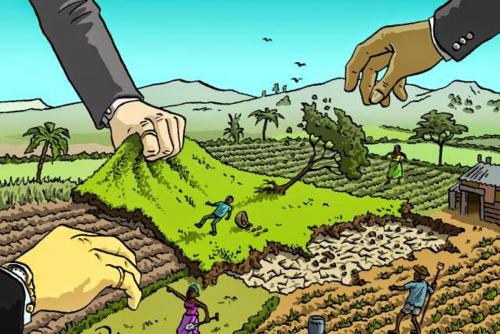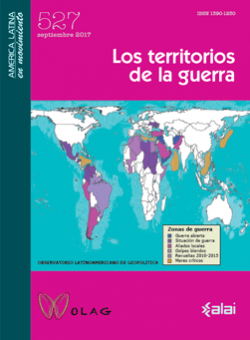A war of territorial dispossession and land-grabbing
Land-grabbing has taken on a global dimension. We can find it in the five continents, but it is a phenomenon that predominates in the periphery.
- Opinión

| Article published in ALAI’s magazine No. 527: Los territorios de la guerra 11/09/2017 |
Disputes for land and territory make up part of the most ancient conflicts of humanity, and at the same time, have been changing in such a way that we can identify the predominant forms and methods of dispossession, as well as the way that antagonistic actors take the lead in these struggles in every historic phase.
We could say that in the XXI century we are seeing a new war for territory and land. This was visible in the crisis of 2007-2008, when a massive number of Latin American and African communities began to disseminate denunciations, through various media and independent organizations, of the seizures that governments and companies were bringing about to occupy their territories. This “land fever” was given the name of “land grabbing”.
Shortly it became clear that the new territorial seizures were more complex than those of other historical periods. In part because the most active subjects in the purchase of land are the large transnational corporations that have consolidated their power and are supported by their governments, their military and economic branches, and by their international institutions, the World Bank (WB) and the International Monetary Fund (IMF), etc.
We also find land acquired by actors that traditionally were not tied to the primary sector. There are big capital funds coming from banks such as Goldman Sachs, powerful persons such as George Soros, former public officials, foundations such as Harvard University, pension funds of workers from countries such as the United States and Canada, that find in the purchase of land a refuge for facing the fall in the quota of profits, generated by the crisis, and at the same time, a sector that, with the high prices of food, petroleum and strategic minerals, was generating significant revenue in the speculative markets.
While the problems of hunger increased for the greater part of the world population, the corporations that dominate the food market such as Cargill, Bunge, Monsanto, Syngenta, among others, registered record profits with an increase of up to 400% . At the same time, petroleum countries that lack farmland, such as the Arab Emirates, Qatar, etc., and countries with a growing middle class, undertook big investments in peripheral lands; this is the case of China and India.
Measuring land-grabbing
Measuring land transfers is not simple. Generally, those interested in this systematization turn to journalistic articles, but the results tend to be dispersed, partial and often not very rigorous. In countries such as Brazil there are official records of land sales to foreigners, but in others, such as Mexico, the official legal documents do not distinguish the privatization and foreign purchase of land. Nevertheless, we have some data to measure the problem.
In the first days of August 2017, Land Matrix, an observatory that monitors the purchase of land since 2000, reported that 1 345 agreements were concluded worldwide, as a result 49 238 484 hectares of land were transferred for cultivation, green programs, mining, roads, tourism, etc. Land-grabbing has taken on a global dimension. We can find it in the five continents, but it is a phenomenon that predominates in the periphery.
According to the monitoring of the organization GRAIN, between 2006 and 2015, the countries of Latin America in which there is an accumulation of land for food production covered an area of 3 927 450 hectares, through 59 acquisitions. This is exclusively a question of foreign investment, where Brazil heads the list with 2 727 502 hectares, followed by Argentina with 513 116, Paraguay with 208 549, Colombia with 154 660, Uruguay with 144 178, Peru with 80 149, Venezuela with 60 000, Bolivia with 57 845, Jamaica with 30 000 and Belize with 1 600.
The origin of foreign investments for land purchase in Latin America is quite diverse: the United States, China, Singapore, Japan, South Korea, Saudi Arabia, India, Denmark, Luxemburg, Holland, France, Germany, the United Kingdom, Canada, Italy and Portugal, among others. But there is also an intraregional land-grabbing phenomenon, in which Brazilian and Argentine capitals predominate. In fact Brazil, together with Japan, is one of the countries that has acquired land in Africa.
Although these figures give a general idea of the problem, hundreds of cases are unregistered or not publically known. If in addition to lands grabbed for food production we add those destined to mining megaprojects, roads, cities, tourism, energy (such as fracking and dams), agrofuels, etc., the figures increase considerably.
In Mexico, for example, the greater part of land dispossession is for touristic development and opencast mining; in the latter, from 2000 to 2012, nearly 2 173 141 hectares of indigenous lands were handed over for mining concessions, according to Eckart Boege. Another example of this is Brazil, where in just 12 contracts registered by Land Matrix of foreign purchases of territory for mining, renewable energy and conservation projects in recent years, the figure of land grabbed amounts to 698 344 hectares.
The imminent challenges
Since 2014, the prices of food and energy sources fell, which meant that foreign investment in lands destined to these uses decreased; nevertheless, territorial dispossession continues. The questions that we must ask are why and for what.
In the first place, it is probable that the accumulation through dispossession that characterizes this historical period is likely to remain for a longer time. The 2007 crisis alerted big capital formed on the basis of the financialization of the level of vulnerability that this kind of wealth involves; in response they have generated new mechanisms to continue commodifying nature, from the air, with environmental services, to seeds.
This implies that the competing States of the intercapitalist war, as well as the companies and their emissaries, the international organizations, are engaged in an intense campaign to institutionalize their territorial acquisitions. During the past ten years, the World Bank and the FAO rushed to establish a series of “principles of responsibility” for the investors, as they promoted the purchase of land, thus seeking to make the illegitimacy and the violence of these processes invisible and to create a “positive” image of dispossession. We should be aware of the articulation of new discourses that ideologically seek to legitimize this barbarism.
Other risks are the new mega agreements that begin to spread throughout the world, such as the Transpacific Partnership Agreement (TPP) that we still cannot consider dead. With these new mechanisms, very unequal conditions are established between central countries and the periphery; they concede greater privileges and legal, economic and armed guarantees for foreign investments. But what do they protect them from? From the peoples, their organization and their resistance. This new international colonial institutional arrangement should be a priority issue for social movements, academics and left parties.
Among the new projects of territorial dispossession, those linked to water occupy a central place. In the style of Hubert Humphrey, US Senator in the 1970s, who cynically said that he had heard that people could become dependent on his country in order to eat, whereby the food dependency of other countries would be marvelous, today many of the big investors think the same about water. For several years, Goldman Sachs, JP Morgan Chase, Citigroup, Deutsche Bank, Credit Suisse, HSBC and others are investing in the occupation of territories where we can find water reserves. According to the organization Friends of the Earth, in 2015 Colombia saw more than 72 conflicts around the privatization of water, Brazil 58, Ecuador 48, Argentina 32, Peru 31 and Chile 30.
Finally, it is necessary, in this phase of transition where capitalism has not yet defined a dominant mode of accumulation, on one hand, to ask timely questions on the actions of the power elites, and on the other to take action around the urgency of articulating a broader social movement in defense of territory and life. It is necessary to put a brake on the wars of capitalism.
(Translated for ALAI by Jordan Bishop)
- Polette Rivero Villaverde: Doctoral candidate in the Post Graduate Programme of Latin American Studies and a member of the Laboratory of studies on transnational enterprises of the IIEc, both of UNAM.
Del mismo autor
Clasificado en
Guerra y Paz
- Prabir Purkayastha 08/04/2022
- Prabir Purkayastha 08/04/2022
- Adolfo Pérez Esquivel 06/04/2022
- Adolfo Pérez Esquivel 05/04/2022
- Vijay Prashad 04/04/2022

